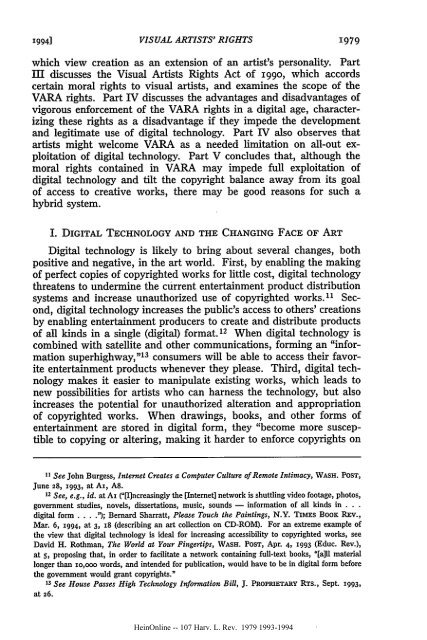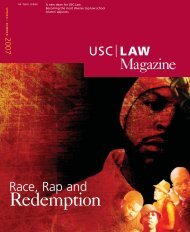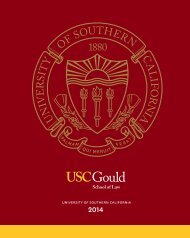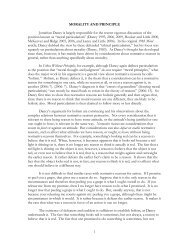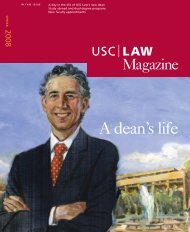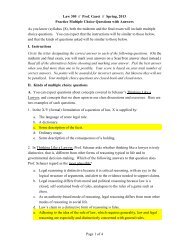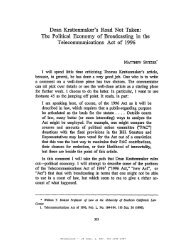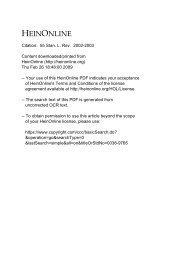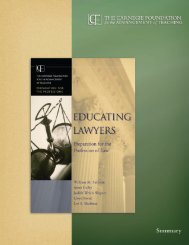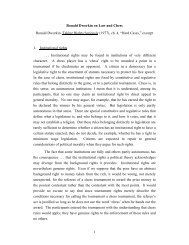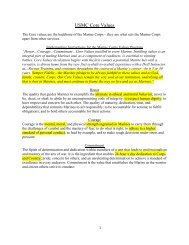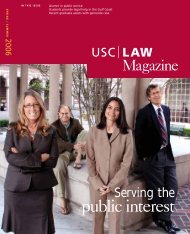EIN NLINE
EIN NLINE
EIN NLINE
Create successful ePaper yourself
Turn your PDF publications into a flip-book with our unique Google optimized e-Paper software.
1994] VISUAL ARTISTS' RIGHTS<br />
1979<br />
which view creation as an extension of an artist's personality. Part<br />
III discusses the Visual Artists Rights Act of 199o, which accords<br />
certain moral rights to visual artists, and examines the scope of the<br />
VARA rights. Part IV discusses the advantages and disadvantages of<br />
vigorous enforcement of the VARA rights in a digital age, characterizing<br />
these rights as a disadvantage if they impede the development<br />
and legitimate use of digital technology. Part IV also observes that<br />
artists might welcome VARA as a needed limitation on all-out exploitation<br />
of digital technology. Part V concludes that, although the<br />
moral rights contained in VARA may impede full exploitation of<br />
digital technology and tilt the copyright balance away from its goal<br />
of access to creative works, there may be good reasons for such a<br />
hybrid system.<br />
I. DIGITAL TECHNOLOGY AND THE CHANGING FACE OF ART<br />
Digital technology is likely to bring about several changes, both<br />
positive and negative, in the art world. First, by enabling the making<br />
of perfect copies of copyrighted works for little cost, digital technology<br />
threatens to undermine the current entertainment product distribution<br />
systems and increase unauthorized use of copyrighted works. 1 Second,<br />
digital technology increases the public's access to others' creations<br />
by enabling entertainment producers to create and distribute products<br />
of all kinds in a single (digital) format.1 2 When digital technology is<br />
combined with satellite and other communications, forming an "information<br />
superhighway,' consumers will be able to access their favor-<br />
3<br />
ite entertainment products whenever they please. Third, digital technology<br />
makes it easier to manipulate existing works, which leads to<br />
new possibilities for artists who can harness the technology, but also<br />
increases the potential for unauthorized alteration and appropriation<br />
of copyrighted works. When drawings, books, and other forms of<br />
entertainment are stored in digital form, they "become more susceptible<br />
to copying or altering, making it harder to enforce copyrights on<br />
11 See John Burgess, Internet Creates a Computer Culture of Remote Intimacy, WASH. POST,<br />
June 28, 1993, at Ai, A8.<br />
12 See, e.g., id. at Ax ("[l]ncreasingly the [Internet] network is shuttling video footage, photos,<br />
government studies, novels, dissertations, music, sounds - information of all kinds in ...<br />
digital form .... ."); Bernard Sharratt, Please Touch the Paintings, N.Y. TIMES BOOK REV.,<br />
Mar. 6, 1994, at 3, i8 (describing an art collection on CD-ROM). For an extreme example of<br />
the view that digital technology is ideal for increasing accessibility to copyrighted works, see<br />
David H. Rothman, The World at Your Fingertips, WASH. POST, Apr. 4, 1993 (Educ. Rev.),<br />
at 5, proposing that, in order to facilitate a network containing full-text books, "[a]ll material<br />
longer than io,ooo words, and intended for publication, would have to be in digital form before<br />
the government would grant copyrights."<br />
13 See House Passes High Technology Information Bill, J. PROPRIETARY RTs., Sept. 1993,<br />
at 26.<br />
HeinOnline -- 107 Harv. L. Rev. 1979 1993-1994


